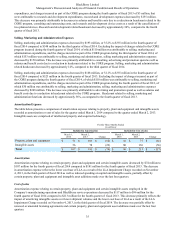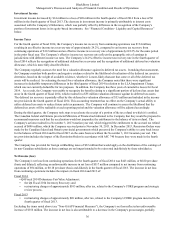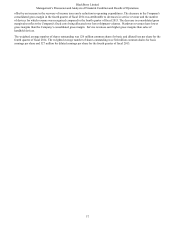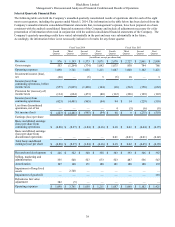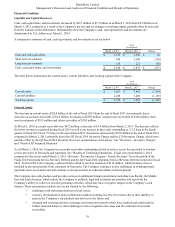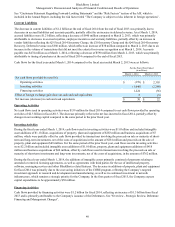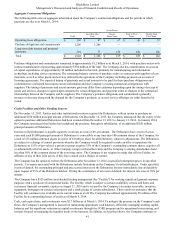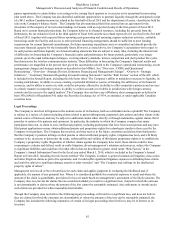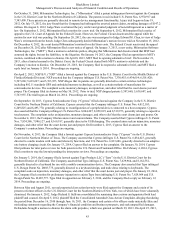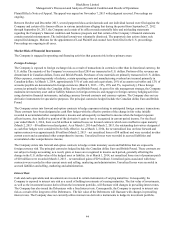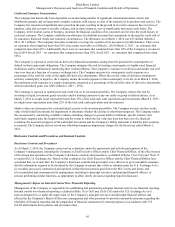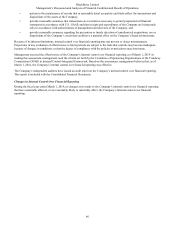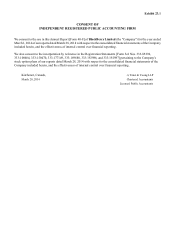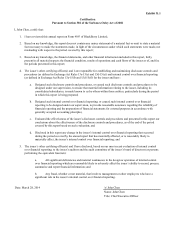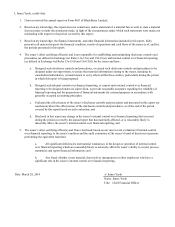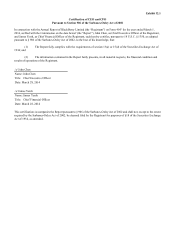Blackberry 2014 Annual Report Download - page 175
Download and view the complete annual report
Please find page 175 of the 2014 Blackberry annual report below. You can navigate through the pages in the report by either clicking on the pages listed below, or by using the keyword search tool below to find specific information within the annual report.BlackBerry Limited
Management’s Discussion and Analysis of Financial Condition and Results of Operations
45
Credit and Customer Concentration
The Company has historically been dependent on an increasing number of significant telecommunication carriers and
distribution partners and on larger more complex contracts with respect to sales of the majority of its products and services. The
Company has experienced significant sales growth in the past, resulting in the growth in its carrier customer base in terms of
numbers, sales and accounts receivable volumes, and in some instances, new or significantly increased credit limits. The
Company, in the normal course of business, monitors the financial condition of its customers and reviews the credit history of
each new customer. The Company establishes an allowance for doubtful accounts that corresponds to the specific credit risk of
its customers, historical trends and economic circumstances. The allowance as at March 1, 2014 was $17 million (March 2,
2013 -$17 million). The Company also places insurance coverage for a portion of its accounts receivable balances. There were
no customers that comprised more than 10% of accounts receivable as at March 1, 2014 (March 2, 2013 – no customers that
comprised more than 10%). Additionally, there were no customers that comprised more than 10% of the Company’s revenue in
fiscal 2014 (fiscal 2013 – no customers that comprised more than 10%; fiscal 2012 – no customers that comprised more than
10%).
The Company is exposed to credit risk on derivative financial instruments arising from the potential for counterparties to
default on their contractual obligations. The Company mitigates this risk by limiting counterparties to highly rated financial
institutions and by continuously monitoring their creditworthiness. The Company’s exposure to credit loss and market risk will
vary over time as a function of currency exchange rates. The Company measures its counterparty credit exposure as a
percentage of the total fair value of the applicable derivative instruments. Where the net fair value of derivative instruments
with any counterparty is negative, the Company deems the credit exposure to that counterparty to be nil. As at March 1, 2014,
the maximum credit exposure to a single counterparty, measured as a percentage of the total fair value of derivative instruments
with net unrealized gains was 100% (March 2, 2013 – 29%).
The Company is exposed to market price and credit risk on its investment portfolio. The Company reduces this risk by
investing in liquid, investment grade securities and by limiting exposure to any one entity or group of related entities. As at
March 1, 2014 no single issuer represented more than 33% of the total cash, cash equivalents and investments (March 2, 2013 –
no single issuer represented more than 22% of the total cash, cash equivalents and investments).
Market values are determined for each individual security in the investment portfolio. The Company assesses declines in the
value of individual investments for impairment to determine whether the decline is other-than-temporary. The Company makes
this assessment by considering available evidence including changes in general market conditions, specific industry and
individual company data, the length of time and the extent to which the fair value has been less than cost, the financial
condition, the near-term prospects of the individual investment and the Company’s ability and intent to hold the debt securities
to maturity. The Company did not record any other-than-temporary impairment charges for the fiscal year ended March 1,
2014.
Disclosure Controls and Procedures and Internal Controls
Disclosure Controls and Procedures
As of March 1, 2014, the Company carried out an evaluation, under the supervision and with the participation of the
Company’s management, including the Company’s Chief Executive Officer and its Chief Financial Officer, of the effectiveness
of the design and operation of the Company’s disclosure controls and procedures, as defined in Rules 13(a)-15(e) and 15(d)-15
(e) under the U.S. Exchange Act. Based on that evaluation, the Chief Executive Officer and the Chief Financial Officer have
concluded that, as of such date, the Company’s disclosure controls and procedures were effective to give reasonable assurance
that the information required to be disclosed by the Company in reports that it files or submits under the U.S. Exchange Act is
(i) recorded, processed, summarized and reported, within the time periods specified in the SEC’s rules and forms, and
(ii) accumulated and communicated to management, including its principal executive and principal financial officers, or
persons performing similar functions, as appropriate to allow timely decisions regarding required disclosure.
Management’s Report on Internal Control Over Financial Reporting
Management of the Company is responsible for establishing and maintaining adequate internal control over financial reporting.
Internal control over financial reporting is defined in Rule 13(a)-15(f) and 15(d)-15(f) under the U.S. Exchange Act as a
process designed by, or under the supervision of, the Company’s principal executive and principal financial officers and
effected by the Company’s Board of Directors, management and other personnel to provide reasonable assurance regarding the
reliability of financial reporting and the preparation of financial statements for external purposes in accordance with U.S.
GAAP and includes those policies and procedures that:


